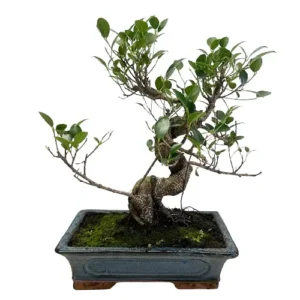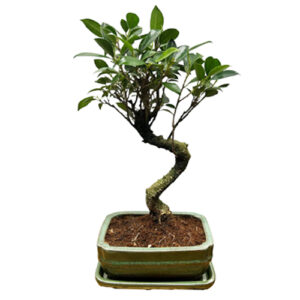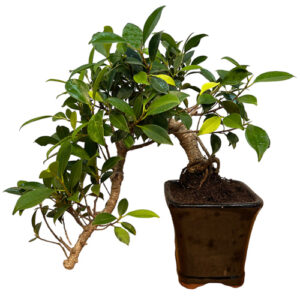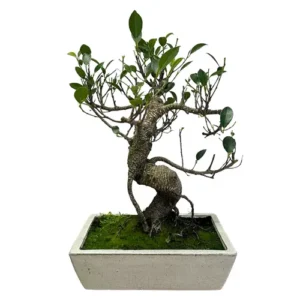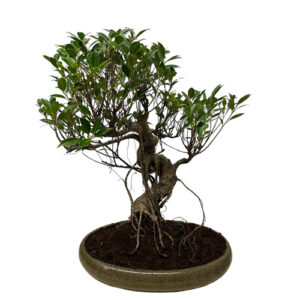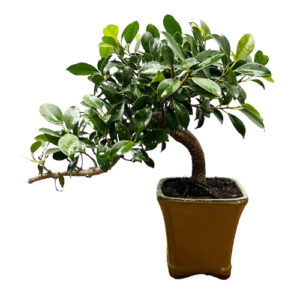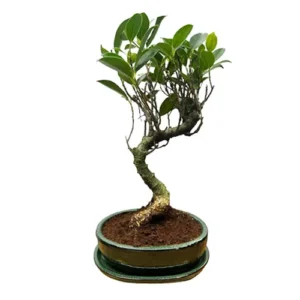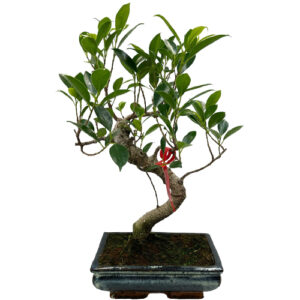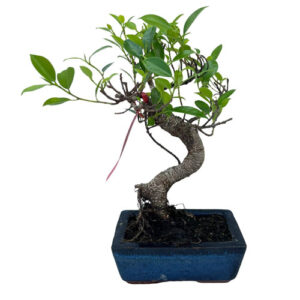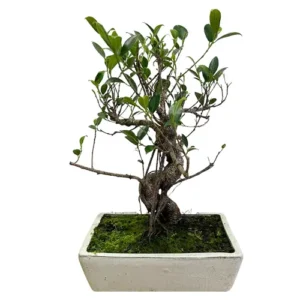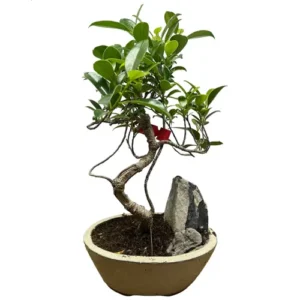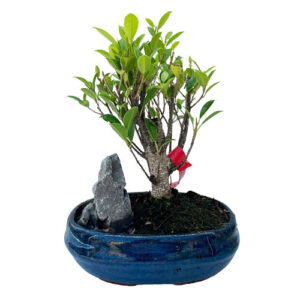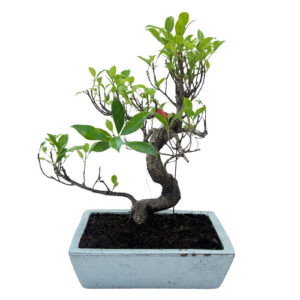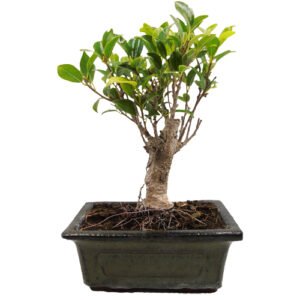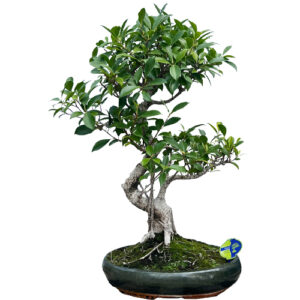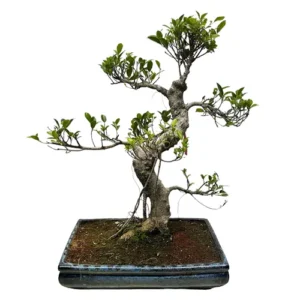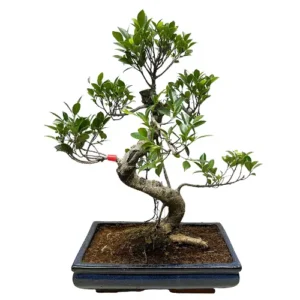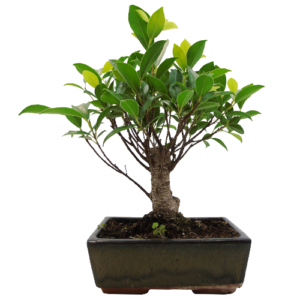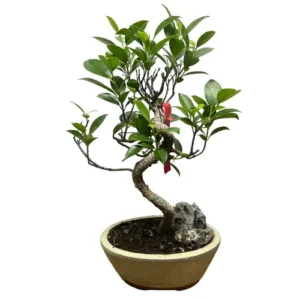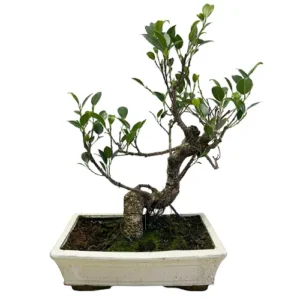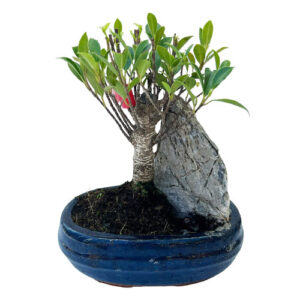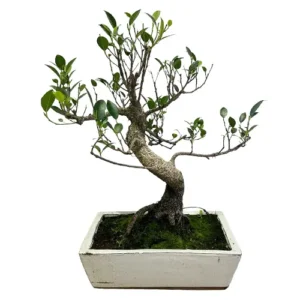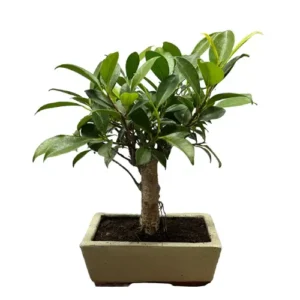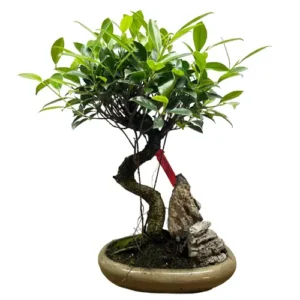Ficus Retusa
Ficus Bonsai
The ficus is the most popular bonsai for beginners, and the genus can be found in most tropical climates around the world, making it the perfect indoor variety. It has lush, waxy dark green leaves as well as the ability to grow aerial roots. The oldest bonsai tree in the world is a 1000-year-old ficus.
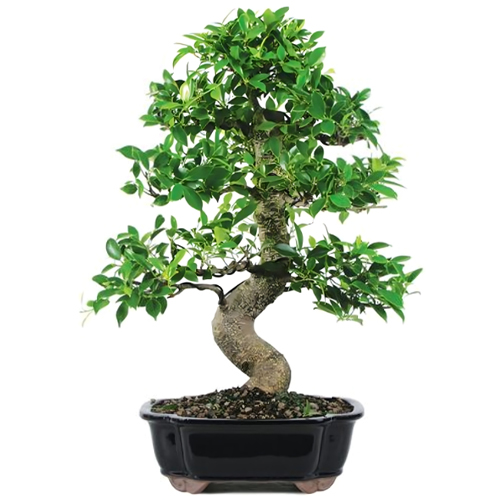
Ficus Bonsai Care Tips
Placement
The ficus bonsai should be kept indoors as it cannot endure frosts. They require a good amount of light so choose a space that receives plenty of full sunlight. If placed in a position with partial shade, keep an eye on the bonsai but this should not be a significant issue as they are a forgiving species which are easy to maintain.
The temperature of the room should be kept relatively constant and make sure you keep it away from central heating and cold draughts as this can dry out the root base. However, they will appreciate being placed outside during the summer to allow new growth, as long as temperatures do not drop below 15 °C. The ficus also benefits from higher humidity levels and will not develop aerial roots without it. Heightened humidity can be achieved by using a mister to spray the leaves, as well as placing a gravel tray under the pot to create a more humid microclimate around the tree.
Watering
There is no definitive guide to watering and it should be conducted on an observational schedule, not a routine. This means that it is important to keep an eye on the moisture levels of the soil to avoid over and under watering, both which can lead to dropping leaves and/or root death. The amount of water a bonsai requires depends on pot size, climate, airflow, soil and tree type so it is best to use your eyes and fingers to assess whether the soil is damp, wet or dry.
If the top inch or so of soil has dried, it is ready to be watered. When you water, try to get an even coverage over the roots and soil, allowing water to flow out from the bottom of the pot to ensure a good soaking.
If you are a first-time bonsai owner, another way to water is by submerging the entire pot in water until the bubbles stop. If you choose this method, be aware that your bonsai may not need watering for another two to four days, but this will depend on the factors mentioned above such as soil type, pot size and climate.
Feeding & Fertilizing
Using fertiliser on your ficus will help encourage healthy growth and this should be done periodically from once a week to every two months and only during the growing season. You can start adding Chrysal Liquid Bonsai Feed to your water from March until October and use weekly. Use Naruko Fertiliser Slow Release Bonsai Feed once every one to two months. With Buddhist Pine trees, less is more, and we tend to advise using half the recommended dosage to see how your Buddhist Pine reacts first.
Pruning & Wiring
Pruning your bonsai is important not only to maintain or create an aesthetic style but to also ensure light and airflow can reach inner leaves and the ficus tolerates pruning very well. The best time to prune is in late autumn and winter. To do this, use appropriate tools to cut back stems which have grown longer than four leaves, leaving the two leaves which are closest to the stem intact. Cover any larger cut wounds with a sealant to avoid losing too much sap. If you want to thicken your bonsai tree’s trunk, allow it to grow freely for one or two years.
Training your bonsai using wiring is best done during the later spring and summer months growing period when the stems and branches are easier to bend. Thin and medium ficus branches are easy to manipulate due to their flexibility. We recommend using wires with a thickness that matches the thickness of the branch: if the wire you choose is too thick you will damage the bark. If it is too thin, it won’t be effective.
Repotting
Repotting your tree is an important way to provide a fresh and suitable soil mix and ensure appropriate root health. Repot in spring. Generally, your ficus will need to be re-potted once every two years if it is young, while older ones can stay in their pots for longer. However, you should always check if it has become root-bound before you change pots. You can do this by lifting the tree gently out of the pot by the main trunk and examining the root system. You will know it is ready if you can see that the roots are circling around each other and the pot. If, however, they still appear contained in the soil, you should place it back and wait until the following spring to check again.
Trees that are ready for repotting will require root pruning, a suitable new pot and appropriate soil mix.
When repotting, do not cut back the root mass by a large amount, and choose a well-draining soil mix that has a neutral or slightly higher PH value of 5-6 but not over 7. We tend to use a mixture of different speciality bonsai soils on our trees. Every species is different so please contact us for free soil-mix advice or to take advantage of our repotting service.
Bonsai make for a one-of-a-kind indoor plant offering elegance, nature and art all in one minute form. Across an array of exquisite and erudite species, they all demand their own specific care and cultivation needs in order for their beauty to flourish. We have an extensive library of care guides for indoor bonsai trees so you can make an informed and considered choice. It’s not about selecting the perfect bonsai, it’s about selecting the perfect bonsai for you.
Ficus Bonsai - Typical Queries
How to propagate a Ficus bonsai tree?
Propagating a Ficus bonsai tree is a way of creating new Ficus bonsai trees from existing ones. Propagating can be done by using cuttings, seeds, or air layering. Cuttings are the easiest and most common method of propagating a Ficus bonsai tree. Cuttings involve taking a healthy branch from a Ficus bonsai tree, cutting it at an angle, and planting it in moist soil or water. Cuttings can root in a few weeks, and then be transferred to a pot and trained as a bonsai. Seeds are another method of propagating a Ficus bonsai tree, but they are more difficult and time-consuming. Seeds involve collecting the fruits from a Ficus bonsai tree, extracting the seeds, and sowing them in moist soil. Seeds can take months or years to germinate, and then require a lot of care and patience to grow into a bonsai. Air layering is a more advanced method of propagating a Ficus bonsai tree, but it can produce larger and more mature bonsai. Air layering involves making a cut on the trunk or branch of a Ficus bonsai tree, wrapping it with moist sphagnum moss and plastic, and waiting for roots to form. Air layering can take several months, and then the rooted section can be cut off and potted as a separate bonsai.
What are the benefits of a Ficus bonsai tree?
A Ficus bonsai tree can offer many benefits for your home and your well-being. A Ficus bonsai tree can purify the air in your home, as it can absorb harmful toxins and release oxygen. A Ficus bonsai tree can also reduce stress and anxiety, as it can create a calming and relaxing atmosphere. A Ficus bonsai tree can also stimulate your creativity and concentration, as it can inspire you to learn new skills and appreciate nature. A Ficus bonsai tree can also beautify your home, as it can add color and charm to any space.
What are the challenges of a Ficus bonsai tree?
A Ficus bonsai tree can also pose some challenges for your care and maintenance. A Ficus bonsai tree can be sensitive to changes in temperature, light, and humidity, and may drop its leaves if it is exposed to cold, draft, or dry air. A Ficus bonsai tree can also be prone to pests and diseases, such as spider mites, scale insects, mealybugs, and fungal infections. A Ficus bonsai tree can also be difficult to shape and style, as it can grow quickly and unpredictably. A Ficus bonsai tree can also be messy, as it can shed its leaves, fruits, and sap.
How to deal with pests and diseases on a Ficus bonsai tree?
Pruning your bonsai is important not only to maintain or create an aesthetic style but to also ensure light and airflow can reach inner leaves and the ficus tolerates pruning very well. The best time to prune is in late autumn and winter. To do this, use appropriate tools to cut back stems which have grown longer than four leaves, leaving the two leaves which are closest to the stem intact. Cover any larger cut wounds with a sealant to avoid losing too much sap. If you want to thicken your bonsai tree’s trunk, allow it to grow freely for one or two years.
Training your bonsai using wiring is best done during the later spring and sum
Pests and diseases can affect the health and appearance of your Ficus bonsai tree, and should be treated as soon as possible. Pests such as spider mites, scale insects, and mealybugs can suck the sap and nutrients from your Ficus bonsai tree, and cause yellowing, curling, or dropping of leaves. Pests can be prevented by keeping your Ficus bonsai tree clean and dust-free, and by spraying it with a mild insecticidal soap or neem oil. Pests can also be removed by wiping them off with a cotton swab dipped in alcohol, or by using a soft brush or tweezers. Diseases such as fungal infections can cause spots, patches, or rotting on your Ficus bonsai tree, and can spread quickly if left untreated. Diseases can be prevented by keeping your Ficus bonsai tree in a well-ventilated and sunny location, and by avoiding overwatering or underwatering. Diseases can also be treated by cutting off the infected parts, and by applying a fungicide or a diluted hydrogen peroxide solution.
mer months growing period when the stems and branches are easier to bend. Thin and medium ficus branches are easy to manipulate due to their flexibility. We recommend using wires with a thickness that matches the thickness of the branch: if the wire you choose is too thick you will damage the bark. If it is too thin, it won’t be effective.
How to grow aerial roots on a Ficus bonsai tree?
Aerial roots are roots that grow from the branches or trunk of a Ficus bonsai tree, and hang down in the air. Aerial roots can give your Ficus bonsai tree a more exotic and natural look, and can also help it absorb more moisture and nutrients. Aerial roots can be grown on a Ficus bonsai tree by providing it with high humidity, warmth, and light. You can increase the humidity around your Ficus bonsai tree by misting it daily, placing it on a tray of pebbles and water, or covering it with a clear plastic bag or dome. You can also encourage aerial roots to grow by wrapping moist sphagnum moss around the branches or trunk, and securing it with a string or a wire. Aerial roots can take several weeks or months to form, and then they can be left to hang freely or attached to the soil or the pot.
How to choose a Ficus bonsai tree?
Choosing a Ficus bonsai tree can be a fun and rewarding experience, as you can find a Ficus bonsai tree that suits your taste and style. There are many factors to consider when choosing a Ficus bonsai tree, such as the size, shape, age, variety, and price. You should choose a Ficus bonsai tree that fits your space and budget, and that has a healthy and attractive appearance. You should also choose a Ficus bonsai tree that matches your skill level and interest, and that has a potential for further development and improvement. You can choose a Ficus bonsai tree from our array of species online or in person at Miyagi Bonsai.

